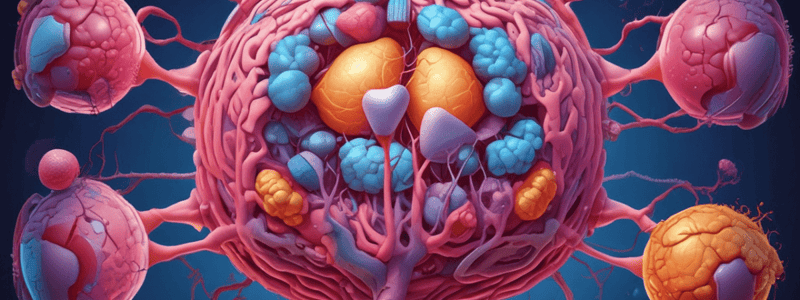Podcast
Questions and Answers
What is the primary function of calcitriol, the active form of vitamin D?
What is the primary function of calcitriol, the active form of vitamin D?
- To decrease the reabsorption of phosphate in the kidneys
- To increase calcium absorption in the gastrointestinal tract (correct)
- To stimulate the production of osteoclasts and increase bone resorption
- To inhibit the production of parathyroid hormone (PTH)
Which of the following best describes the relationship between parathyroid hormone (PTH) and the kidneys?
Which of the following best describes the relationship between parathyroid hormone (PTH) and the kidneys?
- PTH acts on the distal convoluted tubules to increase calcium reabsorption
- PTH acts on the proximal convoluted tubules to decrease renal phosphate reabsorption
- PTH stimulates the kidney enzyme 1-alfa-hydroxilase to convert calcidiol to calcitriol
- All of the above (correct)
Which of the following cell types is responsible for the destruction and reabsorption of bone tissue?
Which of the following cell types is responsible for the destruction and reabsorption of bone tissue?
- Osteocytes
- Osteogenic cells
- Osteoclasts (correct)
- Osteoblasts
What is the primary function of calcitonin, a hormone produced by the thyroid gland?
What is the primary function of calcitonin, a hormone produced by the thyroid gland?
Which of the following is the primary source of vitamin D2 for humans?
Which of the following is the primary source of vitamin D2 for humans?
What is the primary function of osteoblasts in bone metabolism?
What is the primary function of osteoblasts in bone metabolism?
How does parathyroid hormone (PTH) affect the kidneys' role in vitamin D metabolism?
How does parathyroid hormone (PTH) affect the kidneys' role in vitamin D metabolism?
Which cell type is responsible for the biomineralization process and maintenance of bone tissue?
Which cell type is responsible for the biomineralization process and maintenance of bone tissue?
What is the role of chief cells in the parathyroid gland?
What is the role of chief cells in the parathyroid gland?
Where is pre-prohormone synthesized in the parathyroid gland?
Where is pre-prohormone synthesized in the parathyroid gland?
What triggers the release of PTH from the parathyroid gland?
What triggers the release of PTH from the parathyroid gland?
Where does PTH have a direct impact on metabolism?
Where does PTH have a direct impact on metabolism?
Which hormone is NOT involved in maintaining calcium homeostasis?
Which hormone is NOT involved in maintaining calcium homeostasis?
What are the actions of oxphil cells in the parathyroid gland?
What are the actions of oxphil cells in the parathyroid gland?
What is the role of calcitriol in calcium metabolism?
What is the role of calcitriol in calcium metabolism?
What happens when calcium and phosphate levels are imbalanced?
What happens when calcium and phosphate levels are imbalanced?
What is the primary effect of decreasing calcium movement from bones to the ECF?
What is the primary effect of decreasing calcium movement from bones to the ECF?
Which hormone is released in response to excessive calcium absorption in the intestines?
Which hormone is released in response to excessive calcium absorption in the intestines?
What is the main role of calcitriol in calcium regulation?
What is the main role of calcitriol in calcium regulation?
How do hind gut fermenters regulate blood calcium levels?
How do hind gut fermenters regulate blood calcium levels?
Which of the following is a direct effect of increasing phosphate movement into bones from the ECF, due to calcitonin?
Which of the following is a direct effect of increasing phosphate movement into bones from the ECF, due to calcitonin?
What is the consequence of insufficient calcitriol in animals?
What is the consequence of insufficient calcitriol in animals?
Which hormone indirectly affects calcium levels by acting on the GI tract?
Which hormone indirectly affects calcium levels by acting on the GI tract?
In hind gut fermenters, what is a unique characteristic of their urine when regulating calcium?
In hind gut fermenters, what is a unique characteristic of their urine when regulating calcium?
What is the primary cause of primary hyperparathyroidism?
What is the primary cause of primary hyperparathyroidism?
How does primary hyperparathyroidism impact the kidneys?
How does primary hyperparathyroidism impact the kidneys?
What is a common symptom of primary hyperparathyroidism related to the urinary system?
What is a common symptom of primary hyperparathyroidism related to the urinary system?
How does primary hyperparathyroidism affect the excitability of the PNS/CNS?
How does primary hyperparathyroidism affect the excitability of the PNS/CNS?
What is a potential cardiovascular manifestation of primary hyperparathyroidism?
What is a potential cardiovascular manifestation of primary hyperparathyroidism?
How is primary hyperparathyroidism typically diagnosed?
How is primary hyperparathyroidism typically diagnosed?
In horses, what is another term for secondary hyperparathyroidism?
In horses, what is another term for secondary hyperparathyroidism?
"Nutritional secondary hyperparathyroidism" is a condition in horses resulting from:
"Nutritional secondary hyperparathyroidism" is a condition in horses resulting from:
What is the main cause of Nutritional Metabolic Bone Disease (NMBD) in reptiles and amphibians?
What is the main cause of Nutritional Metabolic Bone Disease (NMBD) in reptiles and amphibians?
What is the main function of oxalates in the diet of reptiles and amphibians?
What is the main function of oxalates in the diet of reptiles and amphibians?
What is the alternative name for Nutritional Metabolic Bone Disease (NMBD) in reptiles and amphibians?
What is the alternative name for Nutritional Metabolic Bone Disease (NMBD) in reptiles and amphibians?
What is the main cause of hypoparathyroidism in reptiles and amphibians?
What is the main cause of hypoparathyroidism in reptiles and amphibians?
What is the effect of low PTH levels in reptiles and amphibians?
What is the effect of low PTH levels in reptiles and amphibians?
What is the main symptom of severe hypoparathyroidism?
What is the main symptom of severe hypoparathyroidism?
How is hypoparathyroidism diagnosed in reptiles and amphibians?
How is hypoparathyroidism diagnosed in reptiles and amphibians?
What is the main cause of Nutritional Secondary Hyperparathyroidism (NSHP) in reptiles and amphibians?
What is the main cause of Nutritional Secondary Hyperparathyroidism (NSHP) in reptiles and amphibians?
Study Notes
Vitamin D Metabolism
- Vitamin D3 is made within the skin using UV or obtained from eggs or oily fish, while Vitamin D2 is only obtained via diet.
- Vitamin D3 or D2 is converted into calcidiol in the liver.
- Calcidiol is converted into calcitriol (active Vitamin D) in the kidneys due to PTH action.
Parathyroid Hormone (PTH)
- PTH acts on the kidneys to increase calcium reabsorption, decrease renal phosphate reabsorption, and stimulate the conversion of calcidiol to calcitriol.
- PTH acts on distal convoluted tubules to increase calcium reabsorption.
- PTH acts on proximal convoluted tubules to decrease renal phosphate reabsorption.
- PTH stimulates the activation of vitamin D in the kidneys.
Calcitriol
- Calcitriol is the active version of vitamin D.
- It is lipophilic and requires transport proteins.
- Calcitriol increases calcium absorption in the GI tract.
- Calcitriol enhances PTH with bone metabolism of calcium.
Bone Metabolism
- Osteocytes are involved in biomineralization and maintaining bone tissue.
- Osteoblasts create bone tissue/matrix.
- Osteoclasts destroy bone tissue (reabsorb bones).
- Osteogenic cells are stem cells.
- Osteoclasts differentiate from monocytes (hemopoietic stem cells).
- Osteocytes differentiate from osteoblasts (mesenchymal stem cells).
Calcitonin
- Calcitonin is produced by parafollicular cells (C-Cells) in the thyroid gland.
- Increased ionized calcium levels in the blood stimulate calcitonin release.
- Calcitonin counterbalances PTH by decreasing ionized calcium levels in the blood.
- Calcitonin decreases calcium movement from bones to the ECF, inhibiting osteoclast reabsorption.
- Calcitonin increases phosphate movement into bones from the ECF, increasing calcium storage.
- Calcitonin increases renal excretion of calcium and phosphate via urine.
- GI hormones (gastrin, secretin, CCK) stimulate calcitonin release when too much calcium is being absorbed in the intestines.
PTH and GI Tract
- Calcitriol stimulates active transport of dietary calcium across intestinal epithelium and regulates ionized calcium levels entering the blood from the diet.
- Without calcitriol, animals won't have enough calcium to support bone structure.
Primary Hyperparathyroidism
- Primary hyperparathyroidism is the excessive secretion of PTH by abnormal chief cells within the parathyroid gland (parathyroid adenomas).
- It causes persistent hypercalcemia and negative feedback control is lost.
- Hypercalcemia impacts kidneys, neuromuscular system, and GI tract.
- Symptoms include polydipsia and polyuria, calcinuria, decreased excitability of PNS/CNS, cardiac arrhythmias, and decreased cell membrane permeability of muscles.
Secondary Hyperparathyroidism
- Secondary hyperparathyroidism is referred to as Nutritional Secondary Hyperparathyroidism (NSH) or "Big Head Disease".
- It is caused by the lack of calcium in the diet, leading to hypermobilization of calcium from the skeleton under the influence of PTH.
- It can also be caused by increased levels of phosphorus, inverted calcium-phosphate ratio, or increased oxalate levels in forages.
- Oxalates prevent the digestion and absorption of calcium.
Nutritional Metabolic Bone Disease (NMBD)
- NMBD is also known as Nutritional Secondary Hyperparathyroidism (NSHP).
- Predisposing factors include low dietary calcium and vitamin D3 intake, inverted calcium-phosphate ratio, and lack of UV-B light exposure.
- Inappropriate diets cause excessive PTH production in response to hypocalcemia, leading to calcium reabsorption from bones and weakened bones.
Hypoparathyroidism
- Hypoparathyroidism is a deficiency of PTH.
- It is caused by idiopathic factors, surgical destruction of the parathyroid gland, or trauma.
- Low PTH levels cause decreased calcitriol production, hypocalcemia, and hyperphosphatemia.
- Symptoms include fever, pain, muscle weakness, cramps, seizures, neuromuscular and neurological signs, cardiac manifestations, skeletal deformities, and other bone effects.
Parathyroid Anatomy
- Most species have 2 pairs of parathyroid glands.
- Rats and pigs have 1 pair located on the poles of the thyroid gland lobes.
- Chief cells secrete PTH.
- Oxphil cells are larger than chief cells and have unknown function.
Hormone Synthesis
- Hormone synthesis involves the synthesis of pre-prohormones in the rER, which are then cleaved into prohormones in the golgi.
- The prohormones are then cleaved into hormones and packaged into secretory vesicles.
- PTH is synthesized in the parathyroid gland.
PTH Synthesis
- PTH synthesis involves the sensing of calcium levels in the blood by calcium sensing receptors on the parathyroid gland's membrane surface.
- Low levels of calcium trigger the release of PTH.
- PTH is synthesized in the rER and cleaved into proPTH in the golgi.
- PTH is then secreted via exocytosis and metabolized by the liver and kidney.
Phosphate and Calcium Metabolism
- Phosphate and calcium are both involved in the metabolism of ATP and AMP.
- Phosphate is also involved in the nucleic acid buffer system.
- 85% of phosphate is found in bones, 14% in intracellular compartments, and 1% in ECF.
- Calcium is involved in muscle contraction, nerve cell activity, blood coagulation, enzyme activation, membrane stability, and structural roles in teeth and bones.
- 99% of calcium is stored in bones, <1% in intracellular compartments, and 0.1% in ECF.
Calcium-Phosphate Ratio
- Phosphate binds to calcium, reducing available ionized calcium.
- More phosphate = more calcium = less ionized calcium.
- Less phosphate = less calcium = more ionized calcium.
- When calcium and phosphate are not balanced, the body will start taking calcium from other parts of the body (like the bones) to help maintain homeostasis.
Studying That Suits You
Use AI to generate personalized quizzes and flashcards to suit your learning preferences.
Related Documents
Description
Test your knowledge of parathyroid anatomy and hormone synthesis in different species. Learn about the chief cells that secrete PTH and the oxphil cells with unknown functions. Explore the chemical structure and synthesis process of parathyroid hormones.




